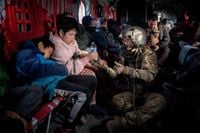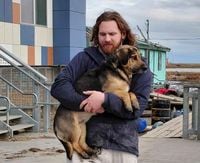When Typhoon Halong barreled into western Alaska in early October 2025, it brought more than just howling winds and towering waves—it delivered devastation on a scale rarely seen in the state’s remote, close-knit villages. As the remnants of the storm battered over 50 communities along Alaska’s western coast, residents watched in disbelief as homes were swept off their foundations, roads disappeared beneath floodwaters, and the very fabric of village life was torn apart.
According to reporting from USA TODAY, the storm’s impact was immediate and catastrophic. Winds reached 100 mph, and storm surges climbed eight feet above the usual high tide, inundating low-lying areas that are home to Alaska Native villages like Kipnuk and Kwigillingok. In Kipnuk alone, the Alaska emergency management agency estimated that 90% of structures were lost; in Kwigillingok, over a third of homes were rendered uninhabitable. The destruction was so severe that, as Governor Mike Dunleavy warned in a letter dated October 17 to President Donald Trump, “more than 1,500 Alaskans will be evacuated to our major cities, many of whom will not be able to return to their communities and homes for upwards of 18 months.”
The human toll quickly became apparent. The Alaska National Guard was mobilized and airlifted more than 600 people out of the disaster zone, with hundreds more following as the days wore on. Some evacuees found temporary shelter in Bethel, the largest city in western Alaska, but as those facilities filled up, survivors were flown on to Anchorage and other cities that had been spared the worst of the storm. Tragically, one woman in Kwigillingok lost her life, and as of mid-October, two people remained missing—a grim reminder of the storm’s ferocity, as noted by AP News.
For those left behind, the situation was dire. “Less than 20 of us that’s trying to rebuild,” Kipnuk resident Sheila Carl told KTUU. “If our ancestors survived this, then we can survive it again.” Yet, as winter loomed, the urgency of the crisis only intensified. Alaska’s harsh arctic climate would soon bring freezing temperatures and icy conditions, complicating recovery efforts and raising fears that “some damaged communities will not be viable to support winter occupancy,” as Dunleavy’s letter to the White House put it.
Officials scrambled to respond. The Yukon-Kuskokwim Health Corporation, working alongside state agencies, began evacuating the most vulnerable residents—elders with complex medical needs and pregnant women—to the regional hospital in Bethel. Aid flowed into the hardest-hit villages, including not just Kipnuk and Kwigillingok but also Tuntutuliak, Napakiak, Chefornak, and Nightmute. By October 19, evacuations had expanded to these additional communities, with the total number of displaced Alaskans reaching approximately 1,800, according to KTUU.
Despite the scale of the disaster, the federal response was, at first, uncertain. Governor Dunleavy formally requested a major disaster declaration from the White House on October 17, seeking federal funding for what was projected to be a recovery effort lasting many months. Alaska Senators Dan Sullivan and Lisa Murkowski backed the request, writing in a joint letter: “With winter fast approaching, and transportation and broadband connectivity limited, there is an urgent need for federal aid to repair housing, restore utilities, and secure heating fuel before severe winter conditions set in.”
On the ground, however, federal agencies were already moving. Senator Murkowski confirmed to KTUU that Federal Emergency Management Agency (FEMA) staff had arrived on Alaska’s western coast, even before the presidential disaster declaration was signed. “They are totally on the ground,” Murkowski said, referencing FEMA’s Region 10 personnel. Jeremy Zidek, spokesperson for the Alaska Division of Homeland Security and Emergency Management, added that the Civil Air Patrol—a federally funded volunteer group—was also assisting with aid and damage assessments. Still, as of October 20, Alaska was not yet listed on FEMA’s disaster declaration database, underscoring the bureaucratic hurdles that can slow relief efforts even as need mounts.
The logistical challenges were immense. Many of the affected villages are reachable only by air or water at this time of year, and most residents rely on hunting and fishing for their food. The sudden relocation to Alaska’s bigger cities meant not just a change of scenery but a complete upheaval of daily life. In Anchorage, Mayor Suzanne LaFrance welcomed evacuees, promising, “We will do everything we can here in Anchorage to welcome our neighbors and help them through these difficult times.” At the Alaska Airlines Center, the Red Cross set up cots and distributed hygiene supplies. Alexie Stone, a Kipnuk resident who arrived in Anchorage with his family, told AP News, “It’s going to be, try to look for a place and find a job. We’re starting a new life here in Anchorage.”
For many, the future remains uncertain. State and federal officials are wrestling with how to provide both immediate relief and long-term solutions. Speaker Bryce Edgmon, addressing the Alaska Federation of Natives conference, said, “We need to give them hope. We also have to give them a roadmap to a brighter future, and a future that doesn’t involve having to wake up in the middle of the night and to feel water coming up from your floor.” Proposals are circulating for a Western Alaska emergency response hub—a partnership between tribal, state, and federal agencies—to better coordinate disaster response in the future. Senator Sullivan called the idea “really good,” and Murkowski said she “loves” the plan.
Meanwhile, those displaced by Typhoon Halong can apply for the State Individual Assistance and Temporary Housing program. The Alaska Airlines Center, officials emphasized, is only a temporary shelter until non-congregate housing can be secured. “While we appreciate your desire to get people back in their homes and in their villages, we need resources to make long-term plans for housing and sustaining these individuals,” legislative leaders wrote in a letter to Governor Dunleavy.
As Alaska faces the twin challenges of recovery and adaptation, the storm has sparked broader conversations about community resilience and climate change. “Things are changing in Alaska, and we have to take stock and have to start planning long-term,” Edgmon said. For now, the focus remains on caring for the displaced and rebuilding what was lost—one family, and one village, at a time.





